Remote Sensing of Daytime Water Leaving Reflectances of Oceans and Large Inland Lakes from EPIC onboard the DSCOVR Spacecraft at Lagrange-1 Point
Abstract
1. Introduction
2. Data and Methods
3. Results
3.1. La Plata River, South America, March 2017
3.2. Great Lakes, North America, September 2017
3.3. Caspian Sea, Black Sea, and Azov Sea, Europe, June 2017
4. Discussion
5. Summary
Author Contributions
Funding
Acknowledgments
Conflicts of Interest
References
- Marshak, A.; Herman, J.; Szabo, A.; Blank, K.; Cede, A.; Carn, S.; Geogdzhaev, D.; Huang, D.; Huang, L.-K.; Knyazikhin, Y.; et al. Earth Observations from DSCOVR/EPIC Instrument. Bull. Am. Meteorol. Soc. 2018, 9, 1829–1850. [Google Scholar] [CrossRef] [PubMed]
- Reichhardt, T. Gore wins approval for his Triana satellite. Nature 1998, 396, 5. [Google Scholar] [CrossRef] [PubMed]
- Herman, J.; Huang, L.; McPeters, R.; Ziemke, J.; Cede, A.; Blank, K. Synoptic ozone, cloud reflectivity, and erythemal irradiance from sunrise to sunset for the whole earth as viewed by the DSCOVR spacecraft from the earth–sun Lagrange 1 orbit. Atmos. Meas. Technol. 2018, 11, 177–194. [Google Scholar] [CrossRef]
- Yang, Y.; Meyer, G.; Wind, Y.; Zhou, A.; Marshak, S.; Platnick, Q.; Min, A.B.; Davis, J.; Joiner, A.; Vasilkov, D.; et al. Cloud Products from Earth Polychromatic Imaging Camera (EPIC) observations: Algorithm and Initial Evaluation. Atmos. Meas. Technol. Discuss. 2018. [Google Scholar] [CrossRef]
- Valero, F.P.J.; Herman, J.; Minnis, P.; Collins, W.D.; Sadourny, R.; Wiscombe, W.; Lubin, D.; Ogilvie, K. Triana—A Deep Space Earth and Solar Observatory; NASA Background Report; NASA: Washington, DC, USA, 1999.
- Salomonson, V.V.; Barnes, W.L.; Maymon, P.W.; Montgomery, H.E.; Ostrow, H. MODIS: Advanced facility instrument for studies of the earth as a system. IEEE Trans. Geosci. Remote Sens. 1989, 27, 145–153. [Google Scholar] [CrossRef]
- King, M.D.; Menzel, W.P.; Kaufman, Y.J.; Tanré, D.; Gao, B.C.; Platnick, S.; Ackerman, S.A.; Remer, L.A.; Pincus, R.; Hubanks, P.A. Cloud and aerosol properties, precipitable water, and profiles of temperature and humidity from MODIS. IEEE Trans. Geosci. Remote Sens. 2003, 41, 442–458. [Google Scholar] [CrossRef]
- Gao, B.-C.; Montes, M.J.; Li, R.-R.; Dierssen, H.M.; Davis, C.O. An atmospheric correction algorithm for remote sensing of bright coastal waters using MODIS land and ocean channels in the solar spectral region. IEEE Trans. Geosci. Remote Sens. 2007, 45, 1835–1843. [Google Scholar] [CrossRef]
- Tanre, D.; Deroo, D.C.; Duhaut, P.; Herman, M.; Morcrette, J.J.; Perbos, J.; Deschamps, P.Y. Description of a computer code to simulate the satellite signal in the solar spectrum: The 5S code. Int. J. Remote Sens. 1990, 11, 659–668. [Google Scholar] [CrossRef]
- Gao, B.-C.; Montes, M.J.; Ahmad, Z.; Davis, C.O. Atmospheric correction algorithm for hyperspectral remote sensing of ocean color from space. Appl. Opt. 2000, 39, 887–896. [Google Scholar] [CrossRef] [PubMed]
- Xu, X.; Wang, J.; Wang, Y.; Zeng, J.; Torres, O.; Yang, Y.; Marshak, A.; Reid, J.; Miller, S. Passive remote sensing of altitude and optical depth of dust plumes using the oxygen A and B bands: First results from EPIC/DSCOVR at Lagrange-1 point. Geophys. Res. Lett. 2017, 44, 7544–7554. [Google Scholar] [CrossRef]
- Yang, Y.; Marshak, A.; Mao, J.; Lyapustin, A.; Herman, J. A Method of Retrieving Cloud Top Height and Cloud Geometrical Thickness with Oxygen A and B bands for the Deep Space Climate Observatory (DSCOVR) Mission: Radiative Transfer Simulations. J. Quant. Spectrosc. Radiat. Trans. 2013, 122, 141–149. [Google Scholar] [CrossRef]
- Jaelani, L.M.; Matsushita, B.; Yang, W.; Fukushima, T. Evaluation of four MERIS atmospheric correction algorithms in Lake Kasumigaura, Japan. Int. J. Remote Sens. 2013, 34, 8967–8985. [Google Scholar] [CrossRef]
- Pick, F.R. Blooming algae: A Canadian perspective on the rise of toxic cyanobacteria. Can. J. Fish. Aquat. Sci. 2016, 73, 1149–1158. [Google Scholar] [CrossRef]
- Winter, J.G.; DeSellas, A.M.; Fletcher, R.; Heintsch, L.; Morley, A.; Nakamoto, L.; Utsumi, K. Algae blooms in Ontario, Canada: Increases in reports since 1994. Lake Reserv. Manag. 2011, 27, 107–114. [Google Scholar] [CrossRef]
- Binding, C.E.; Greenberg, T.A.; McCullough, G.; Watson, S.B.; Page, E. An analysis of satellite-derived chlorophyll and algal bloom indices on Lake Winnipeg. J. Great Lakes Res. 2018, 44, 436–446. [Google Scholar] [CrossRef]
- Available online: https://earthobservatory.nasa.gov/images/91017/bloom-persists-in-lake-erie (accessed on 8 March 2019).
- Available online: https://www.sciencedirect.com/science/article/pii/S0380133018301874 (accessed on 8 March 2019).
- Xiong, X.X.; Butler, J.; Chiang, K.; Efremova, B.; Fulbright, J.; Lei, N.; McIntire, J.; Oudrari, H.; Sun, J.; Wang, Z.; et al. VIIRS on-orbit calibration methodology and performance. J. Grophys. Res. Atmos. 2013, 119, 5065–5078. [Google Scholar] [CrossRef]
- Kidder, S.Q.; Vonder Haar, T.H. Satellite Meteorology—An Introduction; Academic Press: San Diego, CA, USA, 1995. [Google Scholar]
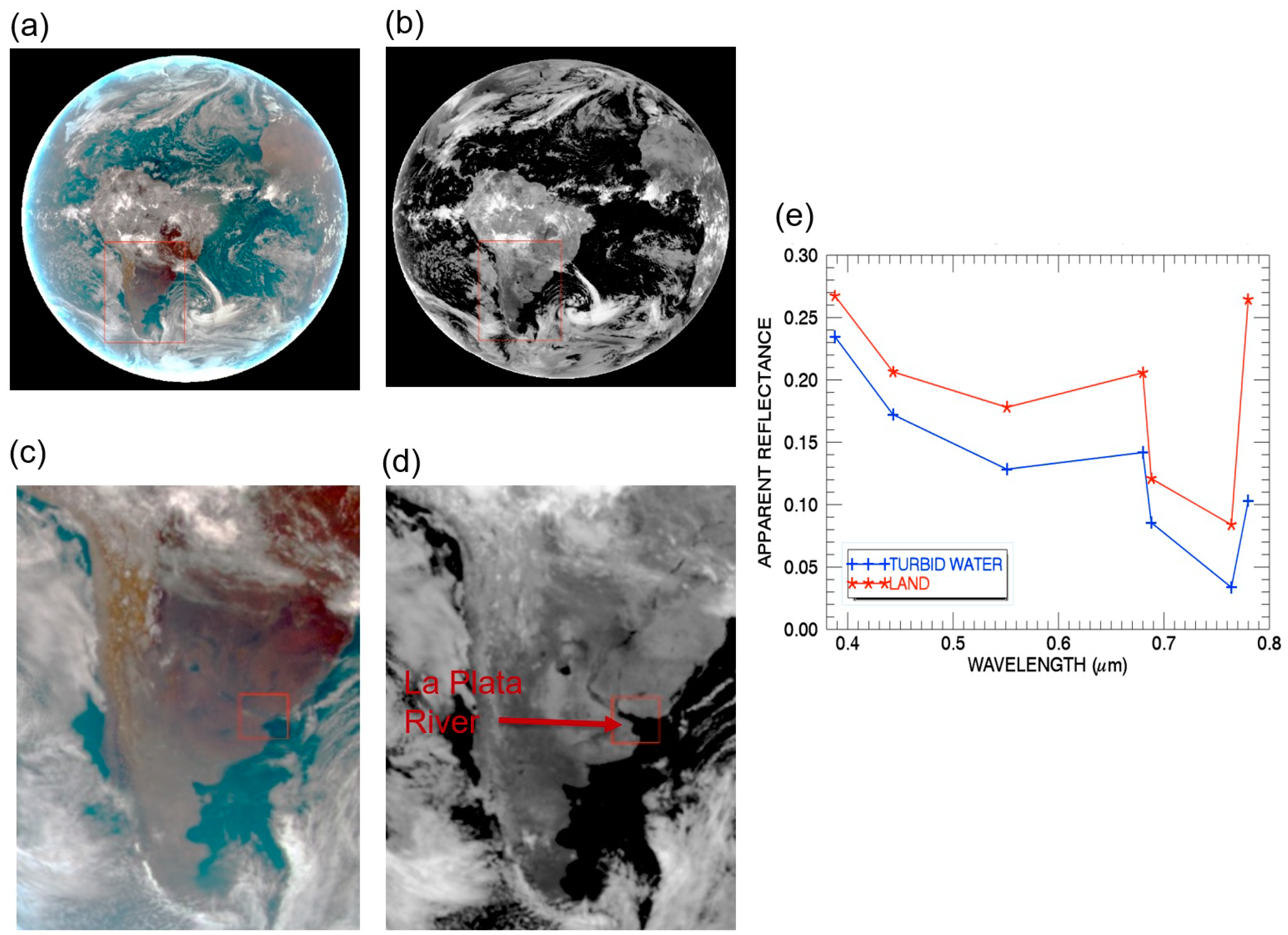
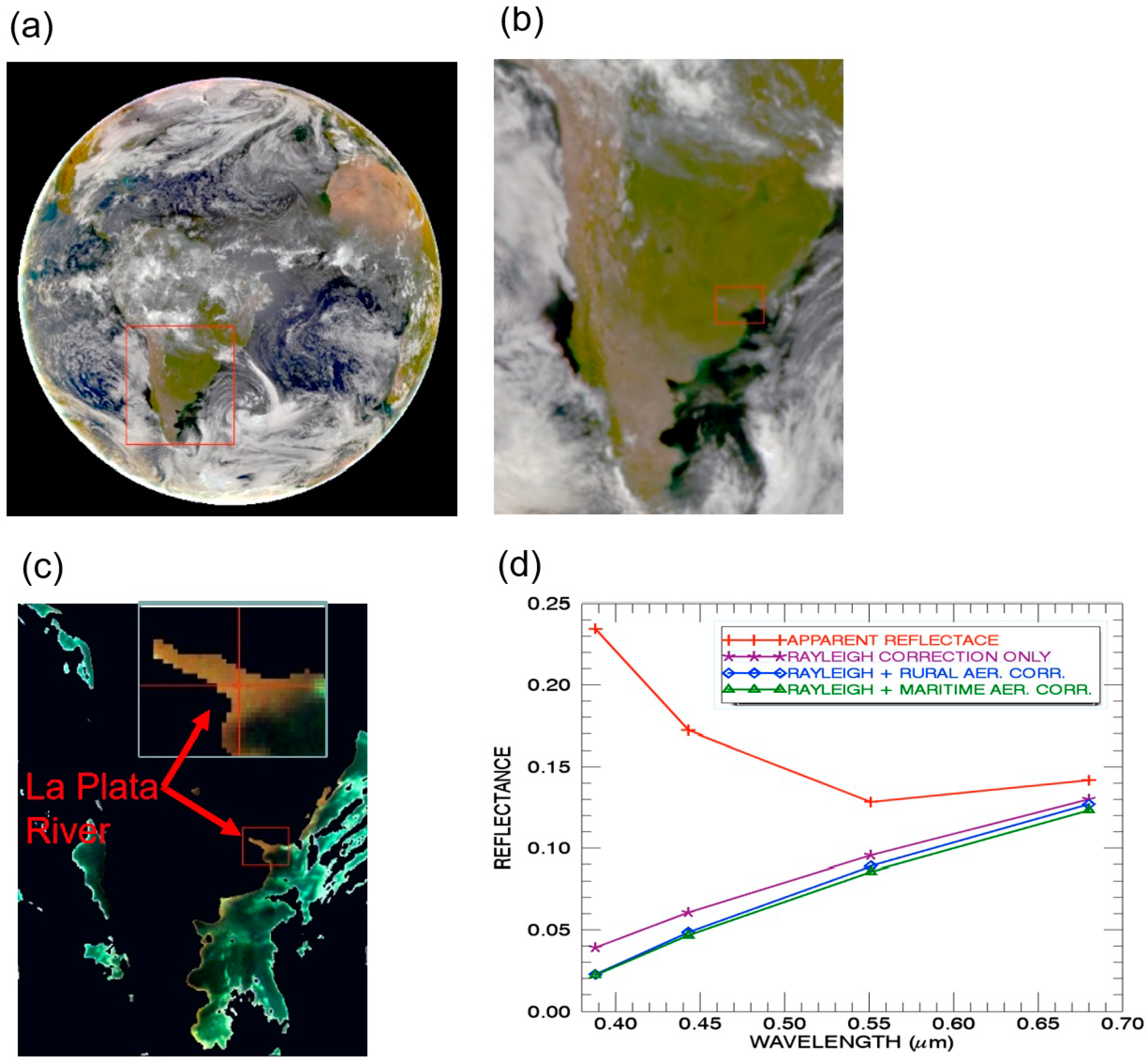
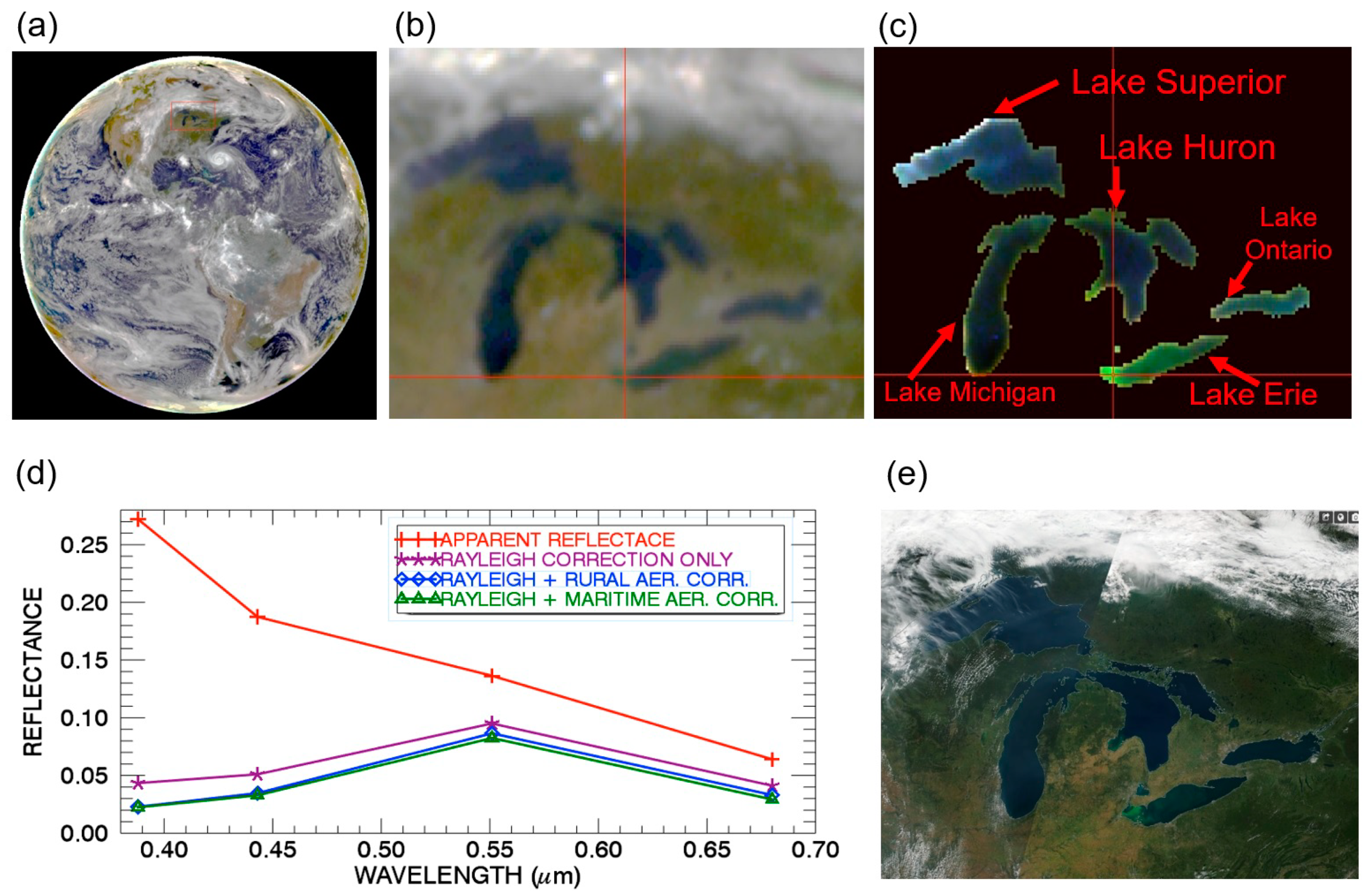
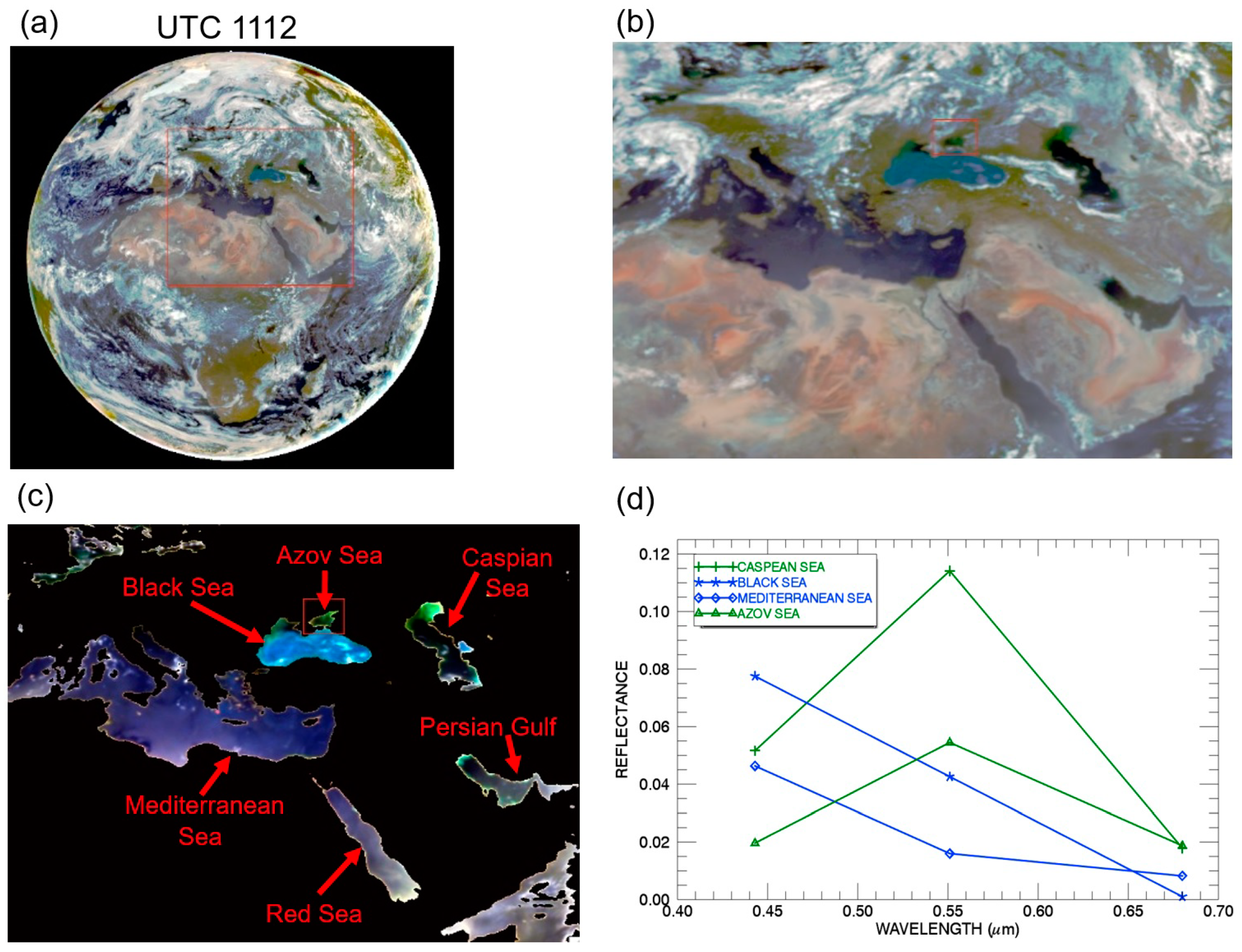
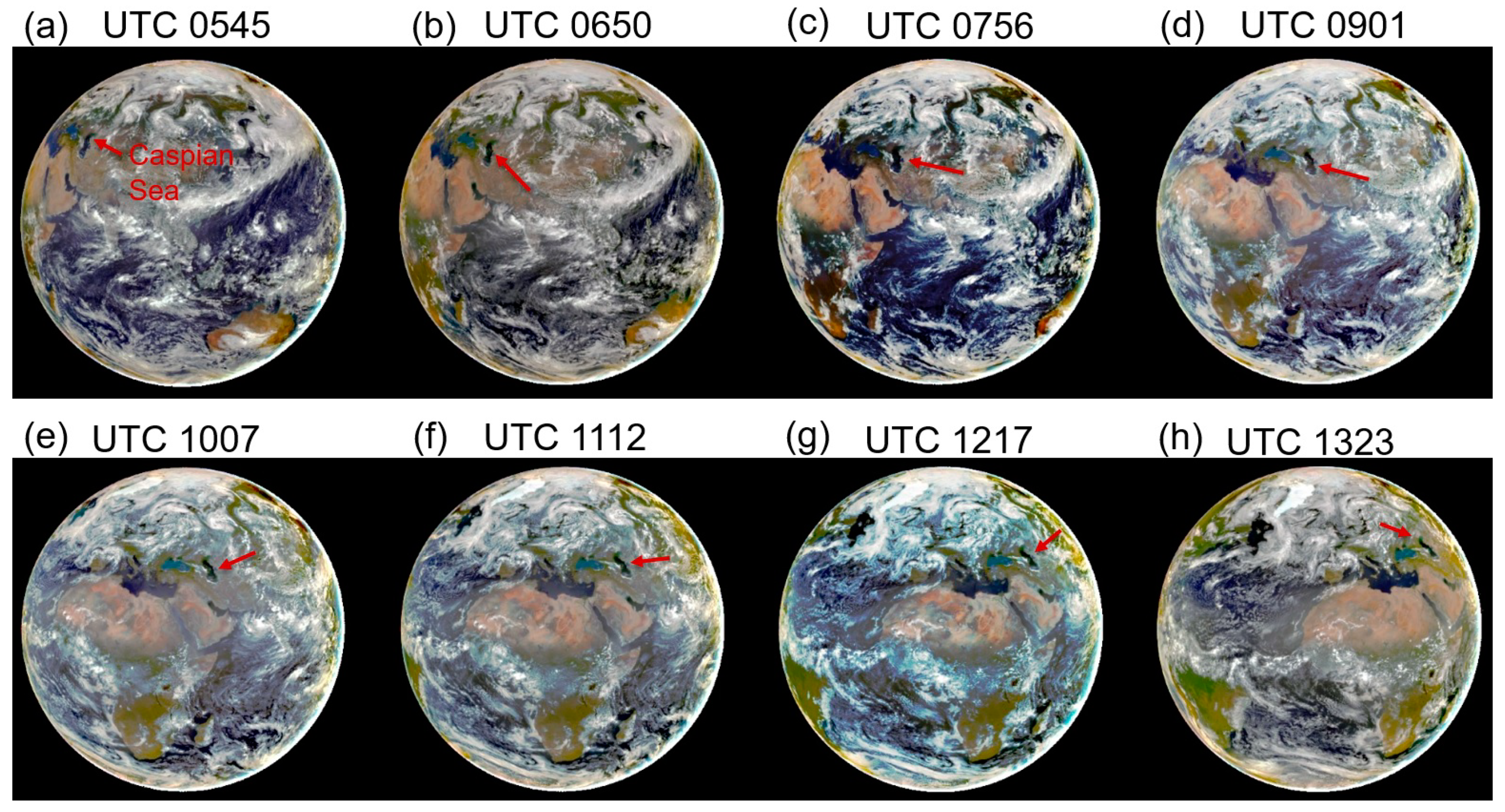
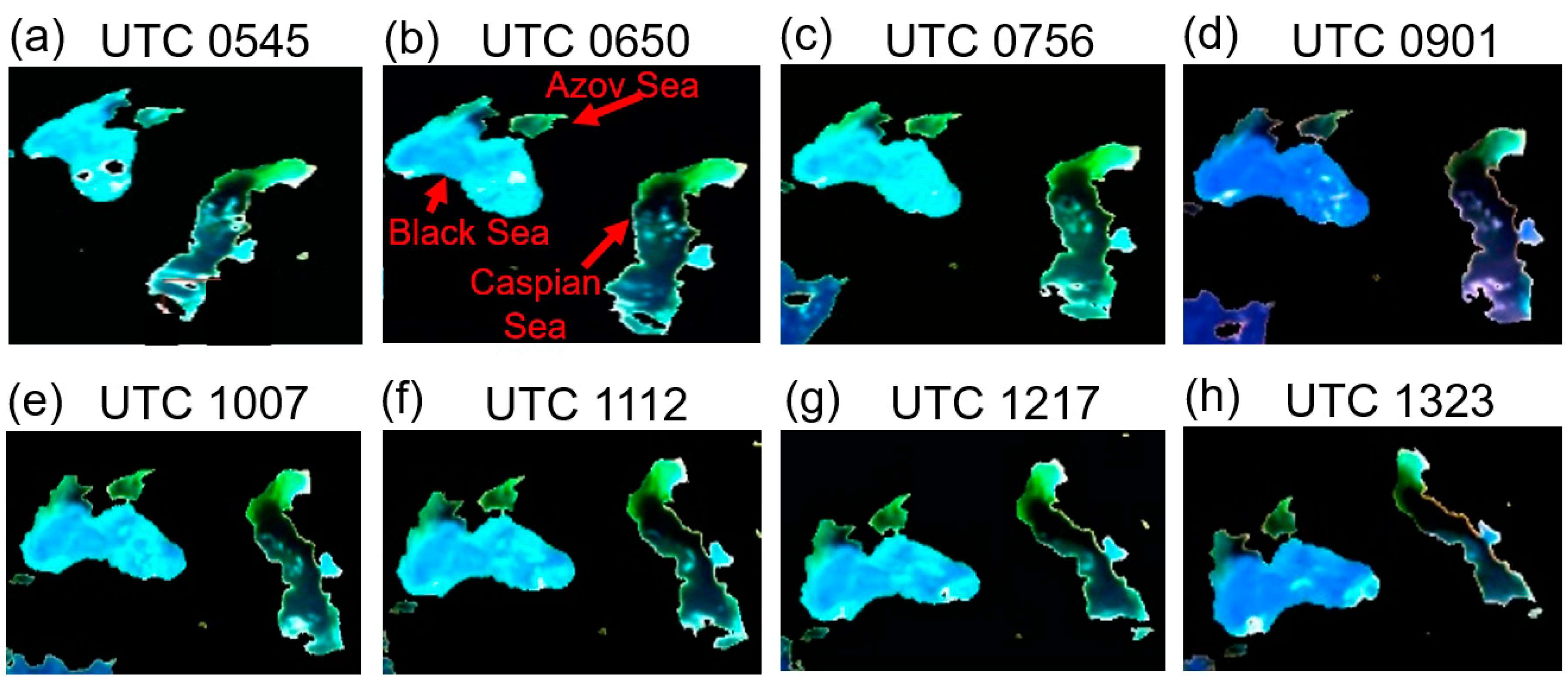
| Spectral Channels (nm) | FWHM (nm) | Primary Usage |
|---|---|---|
| 317.5 | 1 | Ozone, SO2 |
| 325 | 2 | Ozone |
| 340 | 3 | Ozone, Aerosols |
| 388 | 3 | Aerosols, Clouds |
| 443 | 3 | Aerosols |
| 551 | 3 | Aerosols, Vegetation |
| 680 | 2 | Aerosols, Vegetation, Clouds |
| 687.75 | 0.8 | Cloud Height |
| 764 | 1 | Cloud Height |
| 779.5 | 2 | Clouds |
© 2019 by the authors. Licensee MDPI, Basel, Switzerland. This article is an open access article distributed under the terms and conditions of the Creative Commons Attribution (CC BY) license (http://creativecommons.org/licenses/by/4.0/).
Share and Cite
Gao, B.-C.; Li, R.-R.; Yang, Y. Remote Sensing of Daytime Water Leaving Reflectances of Oceans and Large Inland Lakes from EPIC onboard the DSCOVR Spacecraft at Lagrange-1 Point. Sensors 2019, 19, 1243. https://doi.org/10.3390/s19051243
Gao B-C, Li R-R, Yang Y. Remote Sensing of Daytime Water Leaving Reflectances of Oceans and Large Inland Lakes from EPIC onboard the DSCOVR Spacecraft at Lagrange-1 Point. Sensors. 2019; 19(5):1243. https://doi.org/10.3390/s19051243
Chicago/Turabian StyleGao, Bo-Cai, Rong-Rong Li, and Yuekui Yang. 2019. "Remote Sensing of Daytime Water Leaving Reflectances of Oceans and Large Inland Lakes from EPIC onboard the DSCOVR Spacecraft at Lagrange-1 Point" Sensors 19, no. 5: 1243. https://doi.org/10.3390/s19051243
APA StyleGao, B.-C., Li, R.-R., & Yang, Y. (2019). Remote Sensing of Daytime Water Leaving Reflectances of Oceans and Large Inland Lakes from EPIC onboard the DSCOVR Spacecraft at Lagrange-1 Point. Sensors, 19(5), 1243. https://doi.org/10.3390/s19051243





